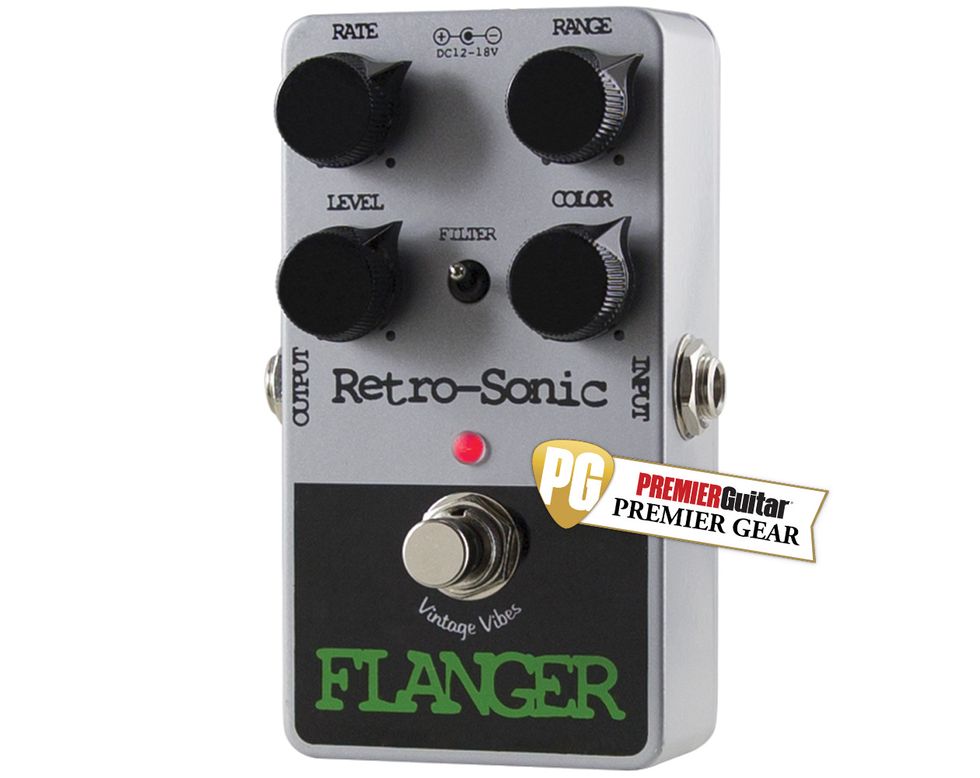RatingsPros:Open, spacious, and rich modulation waves. Excellent quality. Useful level control. 18-volt option. Cons: Could use a touch more top-end sparkle. Street: $199 Retro-Sonic Flanger retro-sonic.com | Tones: Ease of Use: Build/Design: Value: |
Fair or not, a lot of ’80s guitar music remains maligned for reliance on chorus. But a lot of what is perceived as chorus on records from that period is really its more flamboyantly weird cousin, the flanger. And some of the most famous and foundational explorations of those tones actually date back to the mid-late ’70s and one very revered flanger in particular, the original 18V Electro-Harmonix Electric Mistress.
That the 18V Mistress is so commonly mistaken for chorus says much about its subtle to surreal range. But its god-like status (and preposterous prices) among vintage flangers is largely attributable to David Gilmour, who embraced the pedal around the 1977’s Animals tour. (Check out the widely circulated and highly regarded Oakland 1977 Pink Floyd bootleg on YouTube to dig the most unsubtle Mistress tones on “Pigs (Three Different Ones)” and “Dogs.”) Andy Summers also used the pedal to swishier, more-chorusy effect on “Walking on the Moon” and a load of other Police jams from the period.
Retro-Sonic’s Flanger is a very deliberate stab at authentically duplicating the sound, functionality, and range of that first EHX flanger. But apart from being a convincing stand-in for the original (it can even be run at an O.G.-style 18 volts), it’s also a forgiving, flexible, and fun flange unit that’s easy to add into any tone recipe for mellow and garish applications alike.
Modulation Mission
The Retro-Sonic is refreshingly no-frills. Simple green-and-black graphics hint at the livery of the original, but the primary focus is on functional authenticity. Rate, range (depth), and color (resonance) retain the same idiosyncratic names that appear on the EHX unit. Retro-Sonic even included the relatively little-used filter switch, which turns the LFO off, freezes the modulation, and removes the rate control—enabling cool out-of-phase, filtered, and ring modulated tones that can be shaped with the range and color controls. Though typically underutilized, it’s a very effective and useful feature, depending on your tastes, and capable of generating many bizarre, clanging textures that take lead melodies and chords to uncommon places.
The big improvement over the original is the added level control, which compensates for the volume drop in original EHX units, but can also provide a considerable dB bump if you want flanged sections to ride high in an instrument mix. And while Retro-Sonic also made the Flanger operable at 18 volts, I did not hear worlds of difference save for a little less compression. More keen-eared flange mavens may well find these slight differences invaluable.
Waves of Gratification
If you had to pick a single attribute that most obviously separates the Retro-Sonic from other compact flangers, it’s open space. There’s just a little more air and blue sky between those waves of modulation—even at aggressive settings that can leave lesser flangers sounding strangled and claustrophobic.
I don’t have an original 18V Electric Mistress. It’s been ages since I tried one, and the blasphemous truth is that I don’t recall the experience as especially extraordinary. Comparisons out there in the videosphere between vintage EHX units and this unit tend to find the Retro-Sonic comparatively dark by a hair. That said, the Retro-Sonic is discernably brighter, more transparent and more oxygenated than the flangers I use (most of which are solid-performing, mass-produced units). It sparkles at most settings when Fender single-coils are upstream. This recipe was especially delicious when I set up the Retro-Sonic for chorusy, rotary-speaker-like application or wilder lead sounds with heavy resonance and depth settings. And in these tone environments, sharper single-coil peaks work with the Retro-Sonic’s extra air and space like a spark in a combustion chamber. Humbuckers, predictably, take up a little more harmonic space between waves and slightly blunt harmonic peaks, creating a washier, foggier effect. But the Retro-Sonic’s superior airiness is that much more reason to consider it as a best-possible pairing for humbucker players, and there are scads of very satisfying tones that can be generated from thicker guitar input—especially if you like beds of molasses-y, liquid flange as underpinning for song verses or rhythm parts. And if you don’t love peaky flange tones, humbuckers can smooth over some of the Retro-Sonic’s combustible edge—particularly with big amps and Brit-flavored amplifiers.
The Verdict
At just less than 200 bucks, the Retro-Sonic isn’t at the “affordable” end of the effect spectrum, but it’s fairly priced when you consider the care that went into conjuring these perceptibly more spacious and inviting flange textures. If flanging is a primary effect or if you plan to use it extensively with fuzz or humbucking pickups, the Retro-Sonic’s low noise, high-headroom, and aerated waves of modulation, make the extra expense well worth it. If you use flanging infrequently or primarily with clean tones, you may be okay with an inexpensive alternative that delivers approximate results for less. Outside considerations of price, however, the Retro-Sonic Flanger is a blast to use and a very satisfying and authentic way to experience ’70s-style flange flavor.









![Rig Rundown: Russian Circles’ Mike Sullivan [2025]](https://www.premierguitar.com/media-library/youtube.jpg?id=62303631&width=1245&height=700&quality=70&coordinates=0%2C0%2C0%2C0)

















